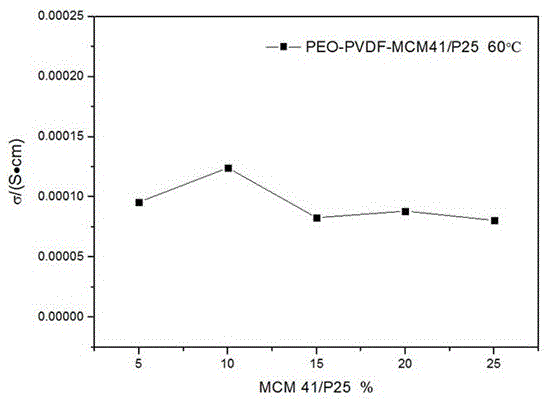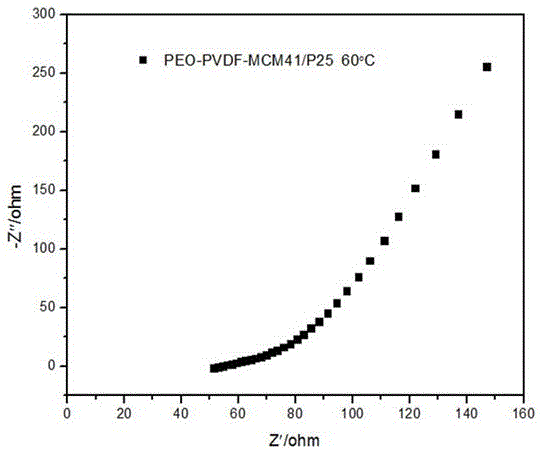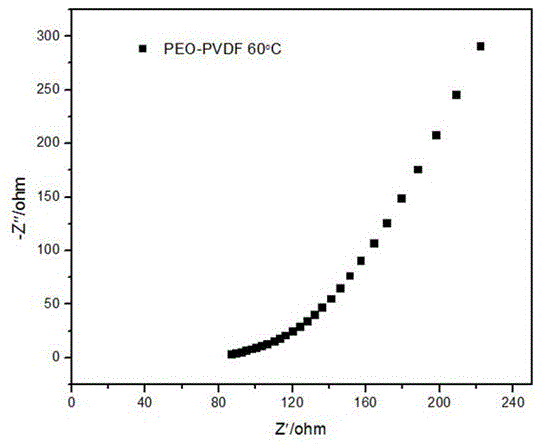Solid-state polymer electrolyte and preparation method thereof
A solid polymer and electrolyte technology, which is applied in the manufacture of electrolyte batteries, non-aqueous electrolyte batteries, electrolyte immobilization/gelation, etc., can solve the problem of low conductivity of solid polymer electrolytes, and achieve superior conductivity performance, method Simple, low internal resistance effect
- Summary
- Abstract
- Description
- Claims
- Application Information
AI Technical Summary
Problems solved by technology
Method used
Image
Examples
Embodiment 1
[0038] Take PEO and PVDF at a mass ratio of 1:1, weigh 1g and dissolve in N,N-dimethylformamide, then weigh 0.10g of lithium perchlorate (LiClO4) and dissolve in this mixed solution, and perform ultrasonication for 20min , make five groups, and then add 0.1g, 0.2g, 0.3g, 0.4g, 0.5g of modified mesoporous silica (MCM41 / P25) respectively, and stir in a water bath at 35°C for 24h.
[0039] The obtained viscous solution was poured on a smooth glass plate, scraped with a spatula, left at room temperature for 2h, and then moved into a vacuum oven at 60°C for 12h. A solid polymer electrolyte is obtained.
[0040] Use a scraper to peel off the solid polymer electrolyte membrane from the glass plate, cut it into an appropriate size, quickly move it into the glove box, and install it into a CR2032 button battery. The EIS test was carried out with an electrochemical workstation and the conductivity was obtained through calculation.
Embodiment 2
[0042] Take PEO and PVDF at a mass ratio of 1:1, weigh 1g and dissolve in N,N-dimethylformamide, then weigh 0.10g of lithium perchlorate (LiClO4) and dissolve in this mixed solution, and perform ultrasonication for 20min , and then add 0.2 g of modified mesoporous silica (MCM41 / P25), and stir in a water bath at 35° C. for 24 h.
[0043] The obtained viscous solution was poured on a smooth glass plate, scraped with a spatula, left at room temperature for 2h, and then moved into a vacuum oven at 60°C for 12h. A solid polymer electrolyte is obtained.
[0044] Use a scraper to peel off the solid polymer electrolyte membrane from the glass plate, cut it into an appropriate size, quickly move it into the glove box, and install it into a CR2032 button battery. EIS tests were performed with an electrochemical workstation.
Embodiment 3
[0046] Take PEO and PVDF at a mass ratio of 1:1, weigh 1g and dissolve them in N,N-dimethylformamide, then weigh 0.05g of lithium tetrafluoroborate and dissolve them in the mixed solution, perform ultrasonication for 20min, and then Add 0.2 g of modified mesoporous silica (MCM41 / P25), and stir in a water bath at 35° C. for 24 h.
[0047] The obtained viscous solution was poured on a smooth glass plate, scraped with a spatula, left at room temperature for 2h, and then moved into a vacuum oven at 60°C for 12h. A solid polymer electrolyte is obtained.
[0048] Use a scraper to peel off the solid polymer electrolyte membrane from the glass plate, cut it into an appropriate size, quickly move it into the glove box, and install it into a CR2032 button battery. EIS tests were performed with an electrochemical workstation.
PUM
| Property | Measurement | Unit |
|---|---|---|
| Surface area | aaaaa | aaaaa |
| Thickness | aaaaa | aaaaa |
Abstract
Description
Claims
Application Information
 Login to View More
Login to View More - R&D
- Intellectual Property
- Life Sciences
- Materials
- Tech Scout
- Unparalleled Data Quality
- Higher Quality Content
- 60% Fewer Hallucinations
Browse by: Latest US Patents, China's latest patents, Technical Efficacy Thesaurus, Application Domain, Technology Topic, Popular Technical Reports.
© 2025 PatSnap. All rights reserved.Legal|Privacy policy|Modern Slavery Act Transparency Statement|Sitemap|About US| Contact US: help@patsnap.com



